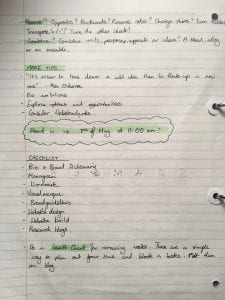Portfolio Sites
One of our deliverables for this module is to design a portfolio website and so since we’ve covered all the other deliverables, this lecture was all about designing a portfolio site.
We first looked at the assessment criteria including how this portfolio site should display an understanding of personal brand identity and how to apply it as well as what that includes. We then did a quick S.W.O.T analysis where we outline our strengths, weaknesses, opportunities and threats in relation to taking on this new project. There is a link to my blog post on this in with my weekly task links at the end of this post.
We then looked at what the goals or purpose of this project could be using Miro by first each writing short mission statements on to sticky notes and then arranging them into a hierarchy. It’s not that the ones in tertiary or secondary weren’t that important because they were. It is just that the one in primary are the main goals of this project. I kinda already pegged onto this and tried moving “unique and memorable” to tertiary (since it’s not really the main reason you’d go design a portfolio site for) but someone else kept moving it back to primary so eventually I gave up and left it. I liked this exercise as I think when we pinpoint the benefits of doing something, it gives us more incentive to put more effort into it.
After that we looked at important steps to take and things consider in the design process of our sites including content planning and wire framing. We first looked at content planning, how our element collages can help for interactive/design elements and just things to consider like formatting, text and the amount of pages. We then got some links to industry people’s portfolio sites to help give us some inspiration for our own.
We then looked at wire framing and how starting on paper is quicker and easier than going start to digital (which you should never do). We looked at a method you can use if you have a lot of ideas where you start by filling small boxes. You then pause and pick the ones you like best and keep repeating the process in higher fidelity and larger boxes until you find the best idea. Then you move on to prototyping, on paper and digitally. I imagine that if I were to go with this method, my wireframes would look a lot less rough and messy and more focused than they end up normally so I think it would be good to try it out.
We looked at some tips including the difference between junior and senior designers and how the junior will have one idea they rigidly stick to and try to force to work. Where as a senior designer makes connections through iterations and analysing what is or isn’t working. I’d like to think I work like the latter but not completely yet so I have to work on that. Another tip was that language shapes text so when you need a place holder find real text as opposed to one sentence repeated over and over or Lorem ipsum (which is still okay, just not the best option).
We also looked at the Osborn Checklist which is meant to help with idea generation. Then we ended with some more tips and a reminder of our hand in date and what we need to have done.
Overall I found this weeks lecture content very helpful. Last semester we did Portfolio sites with Paul but then the focus was learning how to use html and apply css. This time I get to actually have a bit of fun with the design of my portfolio site and this lecture was able show me the things I should consider and approaches I could take to the design process.
This Week’s Tasks






